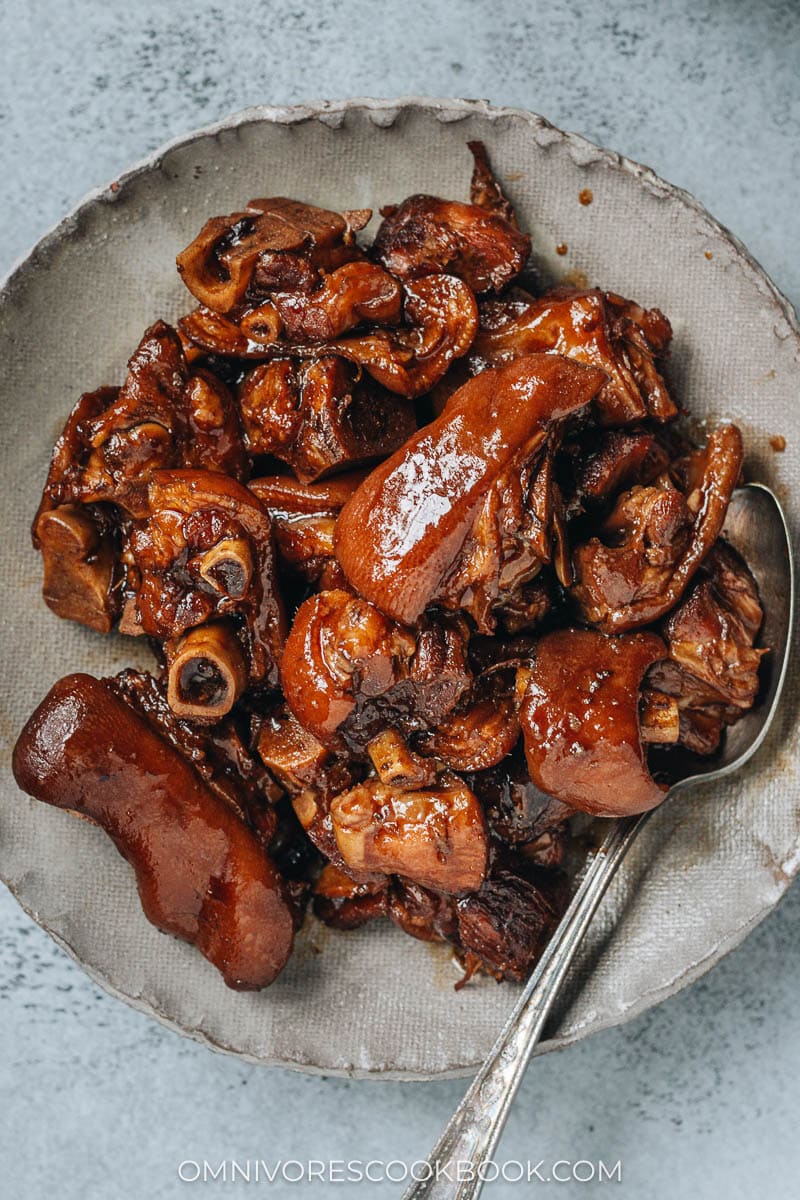
Chinese cuisine is known for utilizing different parts of the whole animal to create delicious meals. For example, chicken liver and pork liver are used to create tasty stir fries. Oxtail makes a super luxurious stew. Beef tripe, lung and tongue with red chili oil makes a rich tasting cold appetizer. Bones are often made into hearty bone broth for noodle soup and stews.
Braised pork trotters is one of my favorite homestyle dishes that my mom has been making since I was a kid. The trotters are carefully boiled first to remove the impurities. They’re cooked until very tender in a pressure cooker, then braised with aromatics and sauces to achieve a rich, savory flavor. The end dish is fall-off-the-bone tender but doesn’t taste greasy at all. The connective tissue becomes so tender, and the lean meat in between just melts in your mouth. On top of steamed rice, it makes a satisfying main dish without breaking the bank.
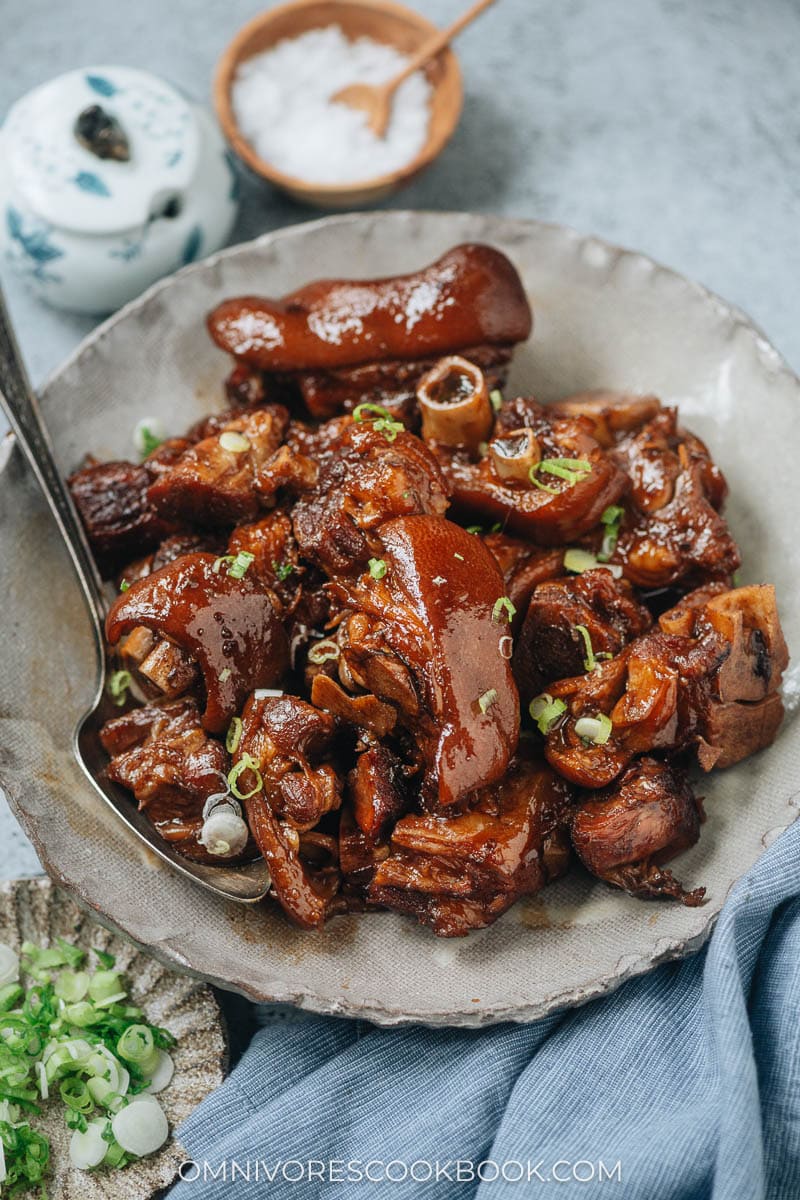
Braised pork trotters ingredients
Pork trotters
You can find pork trotters at most Chinese markets and Asian online grocery deliveries. These days, most shops sell the pre-cut trotters that you can cook directly. If you’re purchasing whole trotters, make sure to let the butcher cut them into large bite-size pieces (they usually cut one trotter into 6 pieces). The butcher has a very sharp saw to make clean cuts, which is much nicer than chopping them at home using a cleaver.
Mise en place
Making braised pork trotters requires a few common pantry ingredients:
- Pork trotters, cut into small pieces
- Aromatics: ginger and green onion
- Spices: star anise, clove, dried chili pepper
- Sauce: dark and light soy sauce, Shaoxing wine, sugar and salt

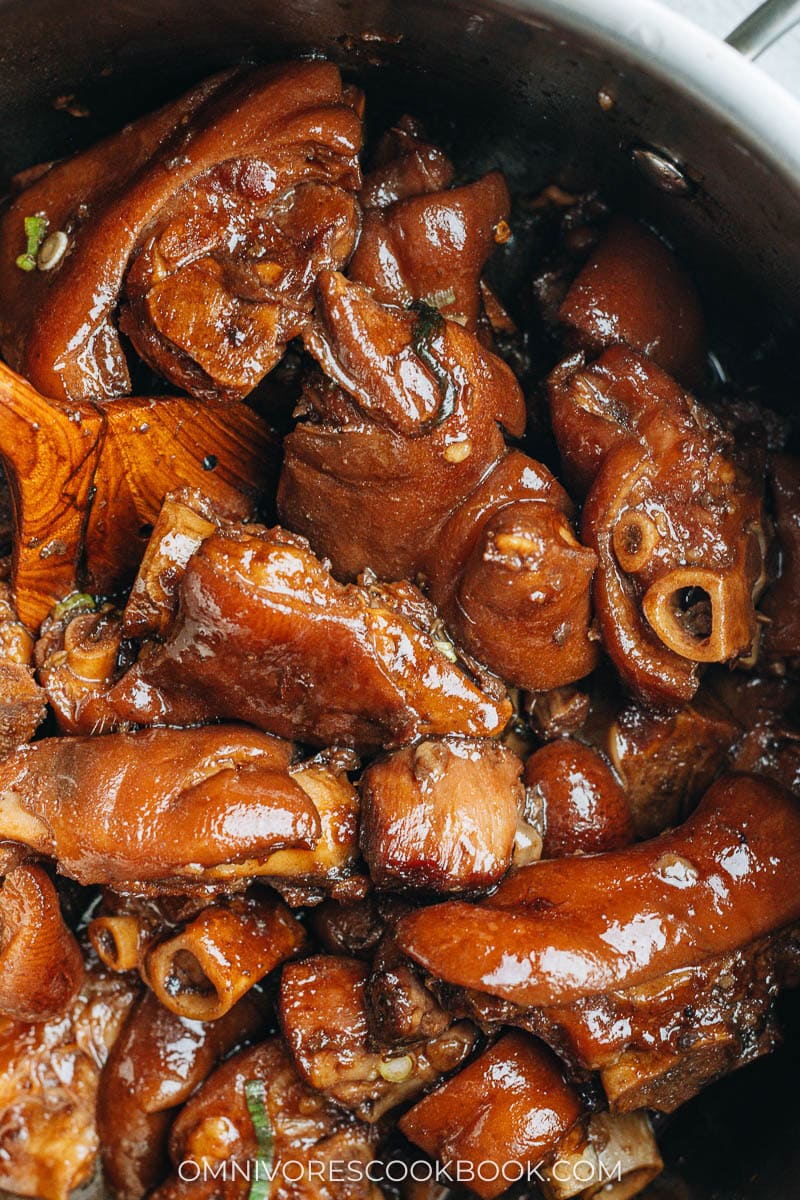
I used rock sugar in this recipe, which gives the sauce a more glossy look. You can use regular sugar as well.

Dark soy sauce is used in this recipe to add an appetizing dark brown color to the sauce. If you don’t have it on hand, you can use regular soy sauce (with a touch of molasses if you have it). The sauce will come out with a lighter color but still be delicious.
Cooking process
Cooking braised pork trotters is quite easy, but it involves a bit of passive waiting time. That’s why I usually prefer to make a large quantity at one time and freeze the portion that I plan to serve later.
- Start the cooking with pork trotters, cold water and ginger
- Once boiling, skim the brown bits off the top
- Boil and skim until the broth almost runs clear
- Transfer the trotters with some of the broth into an Instant Pot or pressure cooker
- Pressure cook until the trotters turn tender
- Move the trotters and the broth to a large pot to cook on the stovetop
- Simmer with aromatics, spices and sauce
- Cook until the pork has become flavorful and super tender
- Reduce the sauce so it becomes thick and glossy
- Add back the pork and mix well
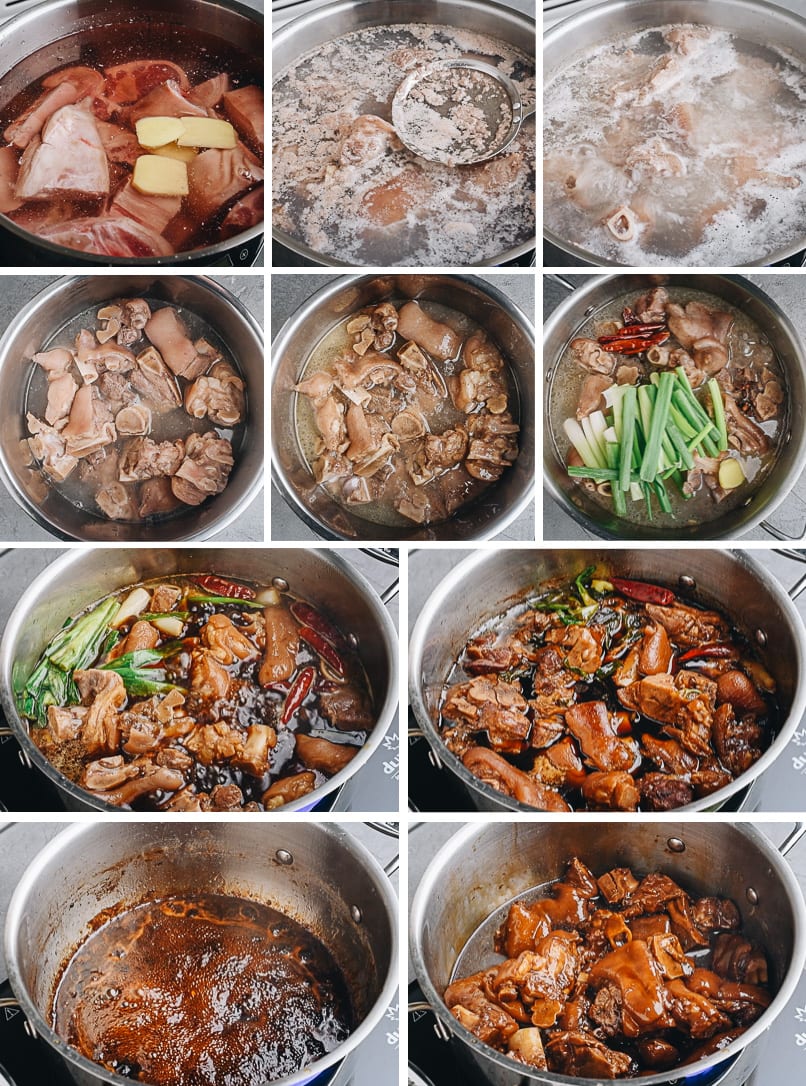
The whole cooking process does take some time, but most of it is passive. I highly recommend making the dish on the weekend, so you won’t be in a hurry and can use the time in between to do other things.
Frequently asked questions
Can I cook braised pork trotters without an Instant Pot?
Yes! It is quite easy to do so but will require a longer cooking time. It will take about 2 hours to simmer the pork in this case.
If you do cook this dish on the stove, I would also add the aromatics and spices at the beginning (once you finish skimming the broth). Then add the sauce ingredients after 1 hour. This will give the pork an even richer taste.
Do I have to reduce the sauce at the end?
I took the extra step of removing the pork from the pot and reducing the sauce, so the sauce will be thick and glossy. The thicker sauce stays on the pork better and gives it a richer flavor.
To simplify this step, you can leave everything in the pot and use high heat to slightly reduce the sauce at the end. In this case, make sure to constantly stir the pot, so the pork won’t stick to the bottom.
It’s also totally OK to not reduce the sauce at all, if you’re happy with the seasoning the way it is.
How to serve braised pork trotters
I always love to serve braised pork trotters over a bowl of steamed rice. Although some Chinese restaurants also serve them in noodle soup. Check out this simple tomato noodle soup recipe if you want to serve the trotters over noodles.
Since braised pork trotters are so rich tasting, I would pair them with a simple side dish such as Fried Cabbage, Baby Bok Choy Stir Fry, Spinach and Peanuts Salad, or Cucumber Salad.
How to reheat and store braised pork trotters
I like to store the extra portion in small containers in the freezer. They stay good for 3 to 4 months. To reheat, the best way is to thaw them overnight in the fridge, then heat them up thoroughly in a steamer. If you haven’t reduced the sauce much, you can also reheat them in a small pot over medium-low heat (you need to stir frequently to prevent it from sticking).
It’s possible to directly reheat them without thawing first, but it will take longer.
Do not heat the trotters in a microwave. The skin and connective tissue don’t heat well and will make explosive sounds. The dish will end up heating up unevenly and leave a mess in your microwave.
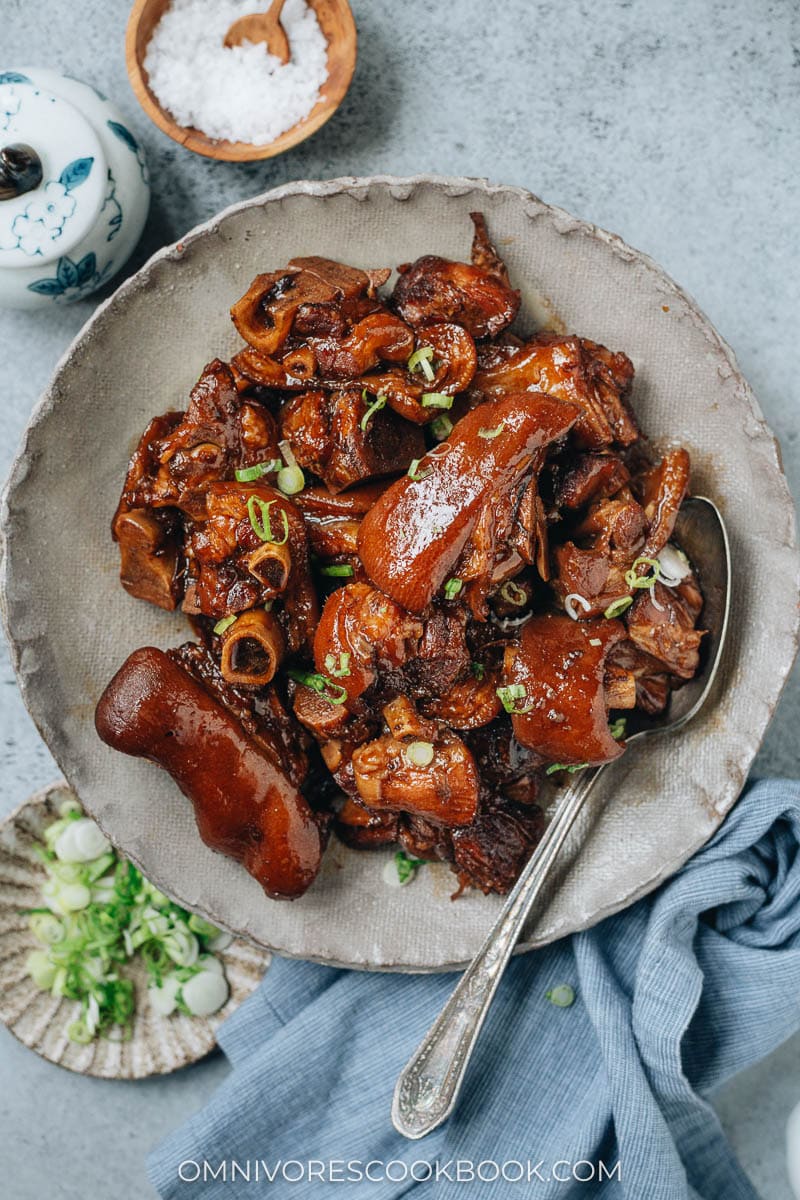
Other delicious make ahead main dishes
- Instant Pot Curry Beef Stew
- Chinese Chicken Dumplings (鸡肉饺子)
- Coca-Cola Chicken Wings (可乐鸡翅)
- Instant Pot Chinese Sausage Rice (腊肠饭)
- Easy Salt Baked Chicken (简易盐焗鸡)
- Chinese Braised Beef Shank (酱牛肉, Jiang Niu Rou)
Chinese Cooking Made Easy
Are you new to this website? This free email series is a great place to start. I’ll walk you through a few of my most popular recipes and show you how and why they work. You’ll quickly start to cook better Chinese food in your own kitchen.
Watch video
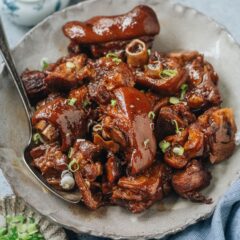
Chinese Braised Pork Trotters (红烧猪蹄)
Ingredients
- 3 to 4 lb pork trotters , cut into large cubes (*Footnote 1)
- 2 thumbs ginger , thickly sliced and divided
- 4 tablespoons Shaoxing wine (or dry sherry)
- 3 tablespoons light soy sauce
- 2 tablespoons dark soy sauce
- 4 green onions , cut into 4” pieces (or 2 Chinese scallions)
- 5 dried Chinese chili peppers
- 2 star anise
- 4 cloves
- 1 heaping tablespoon rock sugar (or regular sugar)
- 2 teaspoons salt
Instructions
- Place the pork trotters and half of the ginger slices in a large pot and add cold tap water to cover. Bring the water to a boil. Stir occasionally to prevent the bottom from sticking. Continue boiling while skimming off the brown foam from the top until the broth is mostly clear, 10 to 15 minutes. Transfer the pork to an Instant Pot (or pressure cooker). If the boiling broth is clear and doesn’t have a strong smell, transfer 5 cups of broth to the pot with the trotters, or until the broth almost covers everything. If the broth looks very cloudy and smells strong, discard the broth and add 5 cups of cold tap water. (*Footnote 2)
- Set the pressure to high and timer to 15 minutes for fall-off-the-bone tender pork (or 12 minutes for tender pork with some texture). Press start. (*Footnote 3)
- Once the Instant Pot is done cooking, release pressure naturally for at least 15 minutes. Then switch the valve to fast release. Transfer pork and the broth back to the large pot.
- Add the rest of the ingredients into the same pot and turn to medium-high heat. After bringing the broth to a boil, reduce to medium-low heat and simmer for 40 minutes or so, until the pork has absorbed a lot of flavor. Stir pork occasionally to avoid burning on the bottom.
- Transfer the pork to a large bowl. Use a ladle to remove and discard the solid spices and aromatics from the broth. Turn to medium-high heat to boil the broth until it reduces to half of the volume and gets thicker, 15 minutes or so. Keep an eye on the broth so it doesn’t reduce too much. The broth will continue to thicken when it cools down a bit, so you don’t need to reduce it too much.
- Add the trotters back to the pot and mix everything together. Serve hot as a main dish. You can store the leftovers in the fridge for 3 to 4 days, or in the freezer for up to 3 to 4 months.
Notes
- If you purchase the pork feet in an Asian market or online, most of the time the pork feet are already pre-cut into cubes. If you purchase whole pork feet, ask the butcher to cut the pork feet into 6 pieces using their saw. This recipe cooks up to 4 lbs (2kg) pork trotters, which is about 4 whole pork trotters.
- The pork will release juice during the cooking process, so you don’t need to add too much water to fully cover the pork.
- To cook without a pressure cooker, add boiled pork, water and all ingredients into a dutch oven. Add the broth (or water) until it covers the pork. Once boiling, simmer for around 2 hours. If the water level becomes too low while pork is still tough, add hot water, 1 to 2 cups at a time, and continue braising once the pork becomes very tender. Reduce the sauce according to step 6 if needed.
Nutrition

Did you make this recipe?
I’d love to hear how it turned out for you! Please take a moment to leave a 5-star rating ⭐️ and share your thoughts in the comments further down the page. It really helps others discover the recipe too.

Meyer
Hi Maggie,I am making this recipe right now but after 30 minutes the meat still seems tough, and there is still a lot of braising liquid so I don’t know if I should uncover and reduce, or leave covered and continue to braise? I am preparing 1 pig’s foot, cut in half lengthwise. The smell and the taste of the braising liquid are delicious, I just hope I don’t ruin the meat.
Maggie Zhu
Just saw this now. It’s totally fine to cover the pot and cook longer. If you braised uncovered and the liquid runs low, you can still add some boiling water without impacting the result too much. Although I wouldn’t add too much water towards the very end. If you ended up with too much broth, you can always use medium high heat to reduce it at the end. Just be careful you need to stir it frequently so the pork doesn’t stick to the bottom.
Ian
I grew up in Hungary where traditionally the whole animal was consumed. Pig trotters were prepared in a paprika sauce, like a goulash. Strangely, horses were a part of our ancient tribal history and no one ever wanted to eat them. Yet during WWII horses were still used to haul big guns and were often killed. Since we the common folks needed meat, we were literally forced to eat horse meat, which is actually quite tasty. In other words, horse meat was considered as a “funny” kind of meat, like pig trotters for some people. After the war it was discovered that horse meat had much less fat than beef, and became an expensive speciality.
Dee
Hi Maggie. I love this recipe. Country folk from the world over even in France and Italy love offal and weird sounding, smelling, looking things because taste-wise, they outrank standard cuts for texture, variety and they are economical. They make delicatessen food out of it and too right, I say. I was about to make a ‘cari pat cochon’ a pigs trotters curry from the island of reunion… I’ll make you mum’s best instead. And will let you know. Thanks for a fantastic site.
Claudette Joanne
I will be trying this recipe tomorrow! Finally found one that I’m comfortable with. I never had pig s feet before!
Dragan
This recipe is our favorite. Especially during the winter is twice a month. Otherwise, we do consume pork feet prepared by the german recipe. Preference is given to your, Chinese, taste.
Jason
I used to eat pork trotters as a child when visiting my best friend who happened to be Chinese. This tastes just like what his mom used to make! You have no idea how much nostalgia cooking this recipe brought me. My favourite dish, thank you so much for sharing this!!
Alisha C Nguyen
This recipe is perfection! Heavenly trotters!
Peter da Graça
I am born and raised in Indonesia, my great grandmother is Chinese, and I also eat all nasty parts of the animal that we slaughter or buy.
I like to cook like the old days, like using pork lard instead of butter or oil.
Linda
While I appreciate your efforts to be sensitive, you are offending others who do not consider these types of foods “scary,” “disgusting,” “strange,” and “weird.” In fact, I would argue that there are more cultures who eat “scary” parts than not. The Reader Alert is unnecessary because why would someone search out a recipe for pork hocks if they found that “uncomfortable?”
I am first generation Taiwanese and I understand cultural differences quite well, but that’s what I consider them–differences. For example, I’m fascinated by the various ways chicken feet are prepared by my Jewish, Italian African, Chinese, Vietnamese, Malaysian, and Taiwanese friends (and those are just the people I know!). I am not easily offended when it comes to such misunderstandings but as I read on, I realized that you have the cultural background (being from Beijing and living in New York) that should give you perspective.
That being said, I do think your recipes look lovely and authentic and greatly appreciate that you are making them available to us all. I hope that many will open their kitchens to trying some new things and discover all the beautiful flavors, textures, smells and sights unfamiliar dishes have to offer!
Thank you for your recipes and the opportunity to post here.
Happy cooking and Happy Year of the Ox!
Rosita Chua
Hi Maggie, I know this recipe is 6 years old. I don’t know if I will still get a response from you. In this recipe, you failed to mention which pork leg to buy. The front leg or the hind leg? It’s quite important for me to know which part to buy to cook this recipe. Please advise and thank you.
Maggie
Hi Rosita, this recipe uses pig trotters and I don’t think it matters too much if you use the trotters from front or back leg.
However if you actually want a pork leg recipe, you can use the front leg and this recipe should work. Or you can use this pork shank recipe here: https://omnivorescookbook.com/braised-pork-shank-with-black-beans
Susan Ellerbrock
Followed recipe . Wonderful results each time I make it!
El
Can I use slow cooker? What is dried chilli peppers? Is it freezer friendly?
Maggie
Yes you can use a slow cooker!
This is the dried chili pepper I used: https://themalamarket.com/collections/all/products/facing-heaven-chili-chao-tian-jiao?aff=2
It adds a nice aroma to the dish without adding too much spiciness. You can usually find it at Asian and Mexican grocery stores (other type of dried chili peppers also work).
And yes, it’s freezer friendly. We usually cook a big batch and freeze them in meal-size portions.
El
Can I use slow cooker? What is dried chilli peppers?
El
Cna you cook it in the slow cooker?
Maggie
I’m pretty sure you can. I would still do the blanch at the beginning so the broth will be clear.
Ivory
Hi I’m making this for dinner tonight thank you for the recipe I am always looking for recipes from foreign countries I love trying different recipes I live in the usa I grew up eating pigsfeet/ trotters as some call them lol
Chris Fung
hah mom gin gee gnok?
jenny
Hello!
Just wondering how you can adapt this recipe for an Instant Pot. Thank you!
Susi V
I made this pork knuckles rather than pig feet (but very bony ones with plenty of sinew and skin 🙂 Very delicious.
This recipe reminded me of a recipe we have in a Chinese cookbook of a rather sweet and gingery braised pig feet dish that the authors said was often made for women to nourish them in the week after giving birth. My partner made me a big pot of it after our first son was born, and braised pig feet have had a special place in my heart ever since!
Susi V
Oops… I see my previous post did make it – it didn’t show after I originally posted it. Sorry for posting twice!
billy
SMILE GIRL SMILE. I have a great asian store in the area with chicken feet ,pig feet, time to reach out and try some new things . Mc Donalds will kill you. We need a food show that uses unconventional food items. There is an opportunity for you. With the insane money people spend on kitchens and stuff we have a new generation of people willing to try new things. Lets them think they are new and influentialtioal. Sorry for the spelling. Get a new REAL food network show going . Go Girl Go
Susi V
Very delicious! I have to confess I didn’t use the actual pig feet but used this recipe to cook pig knuckles, so still got the tasty sinews and skin but also some extra meat.
We have a Chinese cookbook with a recipe for a very gingery and rather sweet pig feet stew that is allegedly a popular dish made for womes who have just had a baby. My partner made me a big pot of it after our first son was born. So pig feet have a special place in my heart 🙂